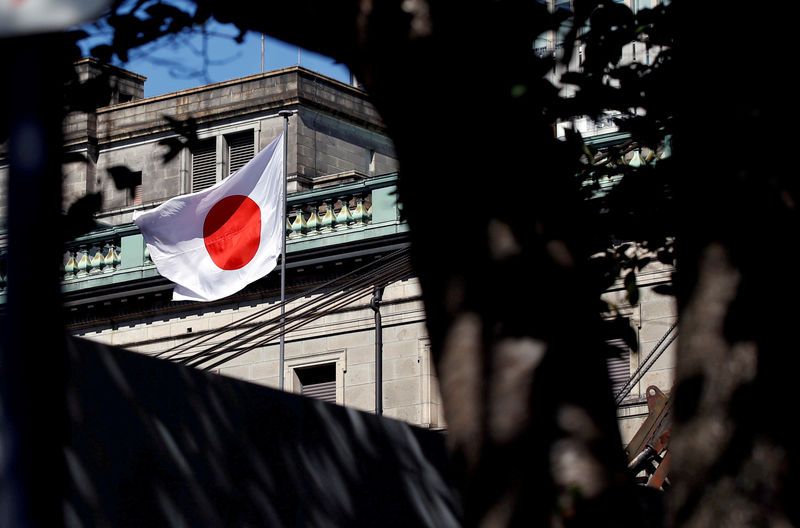 © Reuters. FILE PHOTO: A Japanese flag flutters atop the Bank of Japan building under construction in Tokyo
© Reuters. FILE PHOTO: A Japanese flag flutters atop the Bank of Japan building under construction in TokyoBy Leika Kihara
TOKYO (Reuters) – When Bank of Japan Governor Haruhiko Kuroda spooked markets last week with talk of winding down the bank’s crisis-mode stimulus, he was describing a goal on the distant horizon – not warning of an imminent shift, say sources familiar with his thinking.
But they say starting discussion of an exit from ultra-loose policy is seen as crucial given the rising cost of easing and the need to give Japanese policymakers some ammunition in case there is another crisis.
Kuroda’s comments – and those of a future deputy – show how the central bank is softening up investor opinion in advance of what will be one of the priorities of his second term as bank governor.
“It’s a tricky process that could take years,” said one of the sources familiar with the central bank’s thinking. “The timing of an actual lift-off really depends on how inflation performs.”
To underscore that the central bank is in no rush to dial back stimulus, Kuroda said his top priority would be to meet his 2 percent inflation target, noting that current inflation, at 0.9 percent in January, remained far from that goal.
The bank must also balance how its moves will be viewed domestically versus globally.
Japanese investors saw Kuroda’s remarks as stating the obvious and barely reacted. Overseas investors reacted more strongly, selling bonds and buying yen as they speculated stimulus would end sooner rather than later.
The Bank of Japan is already well into what analysts call “stealth tapering” as it slows annual bond buying to nearly half the pace it loosely pledges.
“The biggest challenge Kuroda faces in his second term is how to unwind the unconventional steps he took in the first five years,” said Takahide Kiuchi, who served at the BOJ board until July.
PUBLIC FOCUS SHIFTING
The yen and Japanese bond yields spiked on Friday when Kuroda told parliament there was “no doubt” the BOJ would “consider and debate” an exit if inflation hits his target during the fiscal year that runs from April 2019 to March 2020.
Masayoshi Amamiya, slated to become one of Kuroda’s two deputies this month, echoed those comments on Monday.
“If the time comes, we’re quite capable technically to gradually and stably adjust interest rates while ensuring markets remain stable,” he told parliament during a confirmation hearing.
The sources warn against reading too much into those remarks, noting that the threshold for even debating an exit remains high.
Although the central bank’s board predicts inflation will hit 2 percent during fiscal 2019, a Reuters poll showed market economists expect inflation to stay at half that level.
Fears of triggering an unwelcome yen rise that could dent Japan’s export-reliant recovery will also shape how the bank discusses an exit strategy.
“If inflation indeed reaches 2 percent, it’s feasible to at least debate an exit. That’s different from saying the BOJ will proceed with an exit immediately,” said a second source who, like the others interviewed for this article, declined to be identified because he was not authorized to speak to the media.
But waiting too long could leave the Bank of Japan with few tools to deal with a future recession.
MARGIN FOR ERROR
After three years of heavy asset buying failed to ignite inflation, the bank in 2016 revamped its policy framework to focus on interest rates.
The result was short-term rates below zero, at minus 0.1 percent, and a 10-year government bond yield around zero percent.
The central bank still buys bonds at an annual pace of roughly 50 trillion yen ($471.56 billion). It has scooped up 40 percent of the 980 trillion yen Japanese government bond market, roughly the same percentage held by private Japanese banks.
But inflation has remained stubbornly low.
Among the few remaining options would be a further rate cut, though many analysts say such a step would do little to spur growth and could backfire by hurting already-thin bank margins.
“Financial institutions are seeing their profits hit, so the BOJ should abandon negative rates,” opposition lawmaker Akio Fukuda told Amamiya in the confirmation hearing on Monday. “I fear we’ll face a terrible situation unless the BOJ heads toward an exit quickly.”
Kuroda said last week the bank’s future policy would take into account growing calls from the public for a credible exit strategy and the impact of its policy on the country’s banking system.
He has said the central bank could also raise its yield target before inflation hits 2 percent, which the bank could present as fine-tuning of stimulus efforts rather than the start of a full-blown policy tightening.
“Kuroda no longer says it’s premature to debate an exit. This is a clear change,” a third source said.
The sources say additional groundwork for the exit could be as subtle as different word choices and changes in tone by central bank policymakers.
But there is uncertainty whether markets would respond to such subtle messages as hoped, posing a huge communication challenge for Kuroda as he heads into his second five-year term in April.
“Kuroda is already softening his stance by allowing bond purchases to slow. He’s effectively already normalizing policy,” said Kiuchi, the former Bank of Japan board member.
Source: Investing.com




























